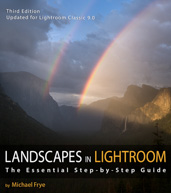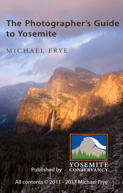In the Moment:
Michael Frye's Landscape Photography Blog
by Michael Frye | Mar 17, 2009 | Photography Tips, Yosemite Photo Conditions
 The spring equinox is only a few days away, and the light is changing rapidly in Yosemite Valley. In winter the rising and setting sun strikes formations on the north side of the valley like El Capitan, Three Brothers, and Yosemite Falls. In summer the best light shifts to the rocks and falls on the south side of the valley – Glacier Point, Sentinel Rock, Cathedral Rocks, and Bridalveil Fall.
The spring equinox is only a few days away, and the light is changing rapidly in Yosemite Valley. In winter the rising and setting sun strikes formations on the north side of the valley like El Capitan, Three Brothers, and Yosemite Falls. In summer the best light shifts to the rocks and falls on the south side of the valley – Glacier Point, Sentinel Rock, Cathedral Rocks, and Bridalveil Fall.
For Yosemite Falls, the best light doesn’t match up with the biggest flow. As the water volume grows in spring, the sun rises further and further north, and the light doesn’t reach the falls until 9:30 to 10:00 a.m. in April and May.
But Bridalveil Fall is better situated for spring light. From late March through about the end of April the sun sets through a gap to the west, and Bridalveil receives beautiful golden light just before sunset. The accompanying photo was made on March 27th, 2007 from Tunnel View. In May and June the light gets cut off earlier, but it’s still nice.
Bridalveil Fall can be photographed from across the river along Northside Drive (location 4 in my book, The Photographer’s Guide to Yosemite), Valley View (location 5), Tunnel View (location 8), or from the Bridalveil Fall parking lot and trail (location 7). You can see a rainbow right from the parking lot between about 5:00 – 6:00 p.m. throughout the spring. (Unfortunately the book is temporarily out of print; it should be available again sometime this spring.)
Poppies Update:
The poppies in the Merced River canyon are still going strong. While the earliest-blooming spots – mainly in the burned areas – may start to fade soon, other areas have just started flowering and should last a little longer.
by Michael Frye | Mar 9, 2009 | Yosemite Photo Conditions

Since my post from February 28th, a little over a week ago, there’s been a poppy explosion in the Merced River Canyon. The acreage in bloom has probably tripled. Most are still in the burned area across the river from Highway 140, two to three miles east of Briceburg, where the flowers now reach to the tops of the ridges, but “Grandy’s Hill,” a bit further east on the highway side of the river, is blazing.
The vantage points looking across the river from the Highway are actually quite good. It’s possible to hike east from Briceburg to be on the poppy side of the river, but you’d have to climb up very steep hillsides to be among the flowers and get a decent view. Grandy’s Hill and most of the other poppy spots also require steep climbs for a close-up view. While these hills aren’t so steep that you’ll die if you fall (at least not in most places), you could easily slip and break and ankle, so don’t attempt this if you’re not agile and sure-footed. The one place where you can reach poppies easily is the beginning of the Hite’s Cove trail.
I made the accompanying photo of poppies and popcorn flowers on one of those steep hillsides yesterday. I used a 200mm lens to compress the space and create a pattern out of the bands of color.
by Michael Frye | Mar 8, 2009 | Announcements
Due to a mixup with my web hosting service, some images have been missing from this blog recently, and all the new additions to my web site were also missing for a period of time. Everything should be okay now, and I apologize any inconvenience or confusion.
by Michael Frye | Mar 2, 2009 | Photography Tips

I’ve made several additions to my web site, including a Tips and Tutorials section, with two tips: one on reading histograms, and another about how to re-create the effect of a graduated neutral-density filter in Photoshop. The foreground of the Mono Lake photo above was lightened using my “digital graduated filter” method. I’ve also added a Books & Posters area, plus an Articles section.
by Michael Frye | Feb 28, 2009 | Yosemite Photo Conditions

It’s still winter in Yosemite, but spring has arrived at lower elevations. Poppies have exploded along the Merced River west of the park. They’re blooming across the river from Highway 140 between Briceburg and the rock-slide detour. The largest, densest patches have sprouted in places burned by the Telegraph Fire last summer, although other poppies are starting to appear in the usual spots further east in the canyon.
I used a 200mm lens to make the image above on my way back from Yosemite this morning. Unfortunately there’s no easy access to the poppies from 140, as they’re all on the opposite side of the river, but it’s possible to photograph them from near the road with long lenses.
The best light on Horsetail Fall is over. In early February the water flow in Horsetail was too low for good photographs. Later in the month the flow increased, but clouds blocked every sunset except one, on February 19th. Consider yourself lucky if you photographed it that day! There were many disappointed photographers in Yosemite this past month. The light on Horsetail in early March can be nice, with a golden glow late in the day, but it’s not the neon orange light that everyone is after.
Water volume in all the Yosemite waterfalls is gradually increasing, and should continue to increase during March and April. A lot of snow has melted, although most of the valley floor is still snow-covered. The forecast is calling for a series of storms next week, which is good news, as we still need more rain and snow.
by Michael Frye | Feb 21, 2009 | Photography Tips, Yosemite Photo Conditions
 On Thursday evening I photographed Horestail Fall from near “Rowell’s View,” one of the small clearings east of the El Capitan picnic area. Two friends and I arrived about 4:30 and got the last two marginal parking spaces. There were easily 100 photographers in the vicinity, most set up right in the plowed parking area – not the best view in my opinion, as it’s too directly underneath the fall. But once we left the picnic area we were virtually alone.
On Thursday evening I photographed Horestail Fall from near “Rowell’s View,” one of the small clearings east of the El Capitan picnic area. Two friends and I arrived about 4:30 and got the last two marginal parking spaces. There were easily 100 photographers in the vicinity, most set up right in the plowed parking area – not the best view in my opinion, as it’s too directly underneath the fall. But once we left the picnic area we were virtually alone.
On Wednesday morning Horsetail was a trickle, but two days of warm weather had increased the flow to perhaps average or slightly-below-average February levels. The light was slightly muted by some haze, but Horsetail still glowed nicely, as you can see by the photo at right. Last night was cloudy, tonight looks the same, and tomorrow and Monday the forecast calls for rain. So Thursday might have been the one good day for photographing Horsetail Fall this year! By Tuesday we are beyond the window for the best light, although it can still be good, especially if the sun breaks through some clouds at the right time.
But all the “bad” weather has done great things for the snowpack, and bodes well for waterfalls and flowers this spring. Keep it coming!
by Michael Frye | Feb 21, 2009 | Yosemite Photo Conditions

On Wednesday morning I got up early to photograph in Yosemite Valley. I knew there was fresh snow in the valley, but I was also hoping for some mist and clearing storm conditions. Sadly there was no mist – just clear blue skies. But it was still beautiful. I made the photo above in a snowy grove of oak trees.
Driving home to Mariposa I was shocked to see poppies – poppies! – along the Merced River west of rock slide detour. It just seems way too early for poppies, but apparently one warm day was all it took. Many were blooming in areas burned by the Telegraph Fire last summer.
by Michael Frye | Feb 15, 2009 | Yosemite Photo Conditions

The next in a long series of winter storms is due to arrive in Yosemite tomorrow. This one is expected to be warmer than the previous two or three; the forecast calls for a snow level of 5000 feet, so it will probably rain at 4000 feet in Yosemite Valley. But the snow level often drops at the tail end of a storm, so it’s possible that the valley floor will get a dusting of fresh snow on Tuesday. Those of you living in the Bay Area who’ve already been drenched by rain may be surprised to hear that we’re not expecting this storm until tomorrow, but it’s stalled and moving slowly.
This past week it snowed in Yosemite on Monday, Wednesday, and Friday, with some misty, clearing-storm interludes in between. I took the photo above on Monday afternoon from Tunnel View. I don’t often make black-and-white images, but this scene was perfect for it. Sunrise yesterday morning looked spectacular on the Turtleback Dome web cam, and I was sorry I didn’t make it up there.
There is now plenty of snow on top of El Capitan to feed Horsetail Fall, but temperatures have been cold, so melting has been slow. We need at least a few warm clear days to get the flow going. The forecast calls for some dry days later this week, but I don’t know whether that will be enough.
By the way, you can find links to the National Weather Service’s Yosemite forecast and the Yosemite web cams on the right.
by Michael Frye | Feb 12, 2009 | Announcements

Two of my images have been included in the Yosemite Renaissance XXIV juried competition, including Oak Leaf Floating in the Merced River, above. The exhibit will be shown at the Yosemite Museum, next to the Visitor Center, from February 27th through May 3rd. A reception will be held on February 27th from 5:30 to 7:30 p.m., where prizes and awards will be announced. This is always a fun event, worth making a trip to Yosemite for!
by Michael Frye | Feb 8, 2009 | Photography Tips, Yosemite Photo Conditions

The National Weather Service is predicting snow tonight and tomorrow down to 3500 feet near Yosemite, and they’ve issued a winter storm warning. They’re expecting unsettled weather all week, with another system arriving Wednesday, and a third around Saturday. In the short term this could mean some great conditions for photography between storms. In the long term this is good news for the state’s water supply, and for photographers hoping for waterfalls and wildflowers.
I was in Yosemite Valley Friday afternoon and all day Saturday for a private workshop. The valley received a few inches of snow Friday morning, but it had all melted by the time I got there. Saturday brought a mix of sun and clouds, though mostly clouds early and late in the day, blocking the best light.
Despite the clouds my student Tom and I found plenty of things to photograph. In the afternoon we headed to the river near the old Camp 6, hoping for Half Dome to emerge from the clouds. Some pretty light on the cottonwoods across the river caught our attention and we temporarily forgot Half Dome. I made a series of images with the white trunks of the cottonwoods and some orange willows, one of which you can see above.
Here’s a little exercise for you: take a quick glance at this photo, then look away. Now answer this question: which is closer to the camera, the white cottonwoods, or the orange willows? After answering take a longer look. I know the image is small, but a close look will reveal that the willows are in front of the cottonwoods. In fact the willows were about 50 feet closer to the camera than the cottonwoods. A 200mm telephoto lens compressed the space and flattened the appearance of the image. Long lenses are great for creating visual juxtapositions between distant objects. I use this telephoto compression all the time to create abstract designs and patterns.
In fact I didn’t just stumble upon this composition. I saw these trees from about two hundred feet further to the left. From that angle the willows were well to the right of the cottonwoods, and trying to include them both would have left too much space in between them. But I knew that if I moved to the right I could position the willows in front of the cottonwoods and might find an interesting juxtaposition.
This ability to think in three dimensions, to imagine what might happen if you move left or right, forward or back, up or down, is an essential photographic skill. Ansel Adams wrote that while sitting in a chair he would often mentally compose images of his surroundings, and imagine how the composition would change if he moved a little to one side, or higher or lower. This is a great exercise – try it sometime!
Here’s hoping that the approaching storms will bring lots of photo opportunities and chances to exercise our composition skills.
 The spring equinox is only a few days away, and the light is changing rapidly in Yosemite Valley. In winter the rising and setting sun strikes formations on the north side of the valley like El Capitan, Three Brothers, and Yosemite Falls. In summer the best light shifts to the rocks and falls on the south side of the valley – Glacier Point, Sentinel Rock, Cathedral Rocks, and Bridalveil Fall.
The spring equinox is only a few days away, and the light is changing rapidly in Yosemite Valley. In winter the rising and setting sun strikes formations on the north side of the valley like El Capitan, Three Brothers, and Yosemite Falls. In summer the best light shifts to the rocks and falls on the south side of the valley – Glacier Point, Sentinel Rock, Cathedral Rocks, and Bridalveil Fall.















